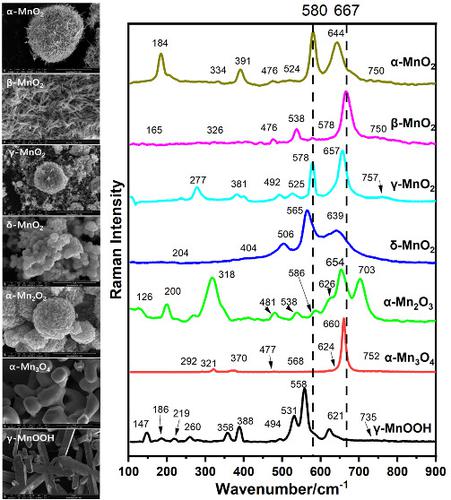当前位置:
X-MOL 学术
›
J. Raman Spectrosc.
›
论文详情
Our official English website, www.x-mol.net, welcomes your
feedback! (Note: you will need to create a separate account there.)
A systematic spectroscopic study of laboratory synthesized manganese oxides relevant to Mars
Journal of Raman Spectroscopy ( IF 2.4 ) Pub Date : 2021-08-15 , DOI: 10.1002/jrs.6231 Yanqing Xin 1, 2 , Haijun Cao 1 , Changqing Liu 1 , Jian Chen 1 , Ping Liu 1 , Yingbo Lu 1 , Zongcheng Ling 1, 3
Journal of Raman Spectroscopy ( IF 2.4 ) Pub Date : 2021-08-15 , DOI: 10.1002/jrs.6231 Yanqing Xin 1, 2 , Haijun Cao 1 , Changqing Liu 1 , Jian Chen 1 , Ping Liu 1 , Yingbo Lu 1 , Zongcheng Ling 1, 3
Affiliation

|
Mn-rich minerals have been found by Mars rovers Curiosity and Opportunity in multiple sedimentary and basaltic outcrops at Gale and Endeavour craters, respectively, though the exact Mn-bearing mineral species and the related geologic processes still need to be confirmed and elucidated. In the Kimberley region at Gale Crater, the Mn content of fracture-filling materials that crosscut sandstone was evaluated to be higher than 25 wt%, indicating the existence of Mn oxides rather than evaporites or other salts. Furthermore, hydrated manganese oxides were also observed in Martian breccia meteorites Northwest Africa 7034 and 7533. However, due to the chemical complexities and often poor crystallinity of Mn-oxide group, there are still difficulties for the quick and accurate phase identification by any single spectroscopic method. In this work, we focus on the systematic spectroscopic studies of seven pure Mn oxides (α-MnO2, β-MnO2, γ-MnO2, δ-MnO2, α-Mn2O3, α-Mn3O4, γ-MnOOH) synthesized in laboratory, which were grown using a set of hydrothermal reaction and solid-state calcination methods. Scanning electron microscope (SEM), energy-dispersive spectrometer (EDS), and laser-induced breakdown spectroscopy (LIBS) were used to obtain the morphology and chemical compositions. X-ray diffraction (XRD) was employed for the phase identification and structural characterization of Mn oxides. Various spectroscopic techniques such as Raman, mid-infrared (MIR), and visible and near-infrared (VNIR) were used to demonstrate their spectral characteristics. We thus established a diverse spectral library including Raman, MIR, VNIR, and LIBS datasets of Mn oxides, facilitating for the phase identifications of Mn-bearing minerals for future applications in Mars explorations missions (e.g., Tianwen-1 orbiter and Zhurong rover and Perseverance rover) as well as terrestrial and other planetary explorations.
中文翻译:

实验室合成的与火星相关的锰氧化物的系统光谱研究
火星探测器好奇号和机遇号分别在盖尔和奋进陨石坑的多个沉积和玄武岩露头中发现了富锰矿物,但确切的含锰矿物种类和相关地质过程仍需要确认和阐明。在盖尔火山口的金伯利地区,横切砂岩的裂缝填充材料的锰含量被评估为高于 25 wt%,表明存在锰氧化物而不是蒸发岩或其他盐。此外,在火星角砾岩陨石西北非 7034 和 7533 中也观察到了水合氧化锰。然而,由于 Mn-氧化物基团的化学复杂性和结晶度往往较差,因此通过任何单一光谱进行快速准确的物相鉴定仍然存在困难。方法。在这项工作中,2 , β-MnO 2 , γ-MnO 2 , δ-MnO 2 , α-Mn 2 O 3 , α-Mn 3 O 4, γ-MnOOH) 是在实验室合成的,它们是使用一套水热反应和固态煅烧方法生长的。使用扫描电子显微镜(SEM)、能量色散光谱仪(EDS)和激光诱导击穿光谱(LIBS)获得形貌和化学成分。X射线衍射(XRD)用于Mn氧化物的相鉴定和结构表征。各种光谱技术,如拉曼、中红外 (MIR) 以及可见和近红外 (VNIR) 被用来证明它们的光谱特性。因此,我们建立了一个多样化的光谱库,包括 Mn 氧化物的拉曼、MIR、VNIR 和 LIBS 数据集,有助于对含锰矿物进行物相识别,以用于未来在火星探测任务中的应用(例如,
更新日期:2021-08-15
中文翻译:

实验室合成的与火星相关的锰氧化物的系统光谱研究
火星探测器好奇号和机遇号分别在盖尔和奋进陨石坑的多个沉积和玄武岩露头中发现了富锰矿物,但确切的含锰矿物种类和相关地质过程仍需要确认和阐明。在盖尔火山口的金伯利地区,横切砂岩的裂缝填充材料的锰含量被评估为高于 25 wt%,表明存在锰氧化物而不是蒸发岩或其他盐。此外,在火星角砾岩陨石西北非 7034 和 7533 中也观察到了水合氧化锰。然而,由于 Mn-氧化物基团的化学复杂性和结晶度往往较差,因此通过任何单一光谱进行快速准确的物相鉴定仍然存在困难。方法。在这项工作中,2 , β-MnO 2 , γ-MnO 2 , δ-MnO 2 , α-Mn 2 O 3 , α-Mn 3 O 4, γ-MnOOH) 是在实验室合成的,它们是使用一套水热反应和固态煅烧方法生长的。使用扫描电子显微镜(SEM)、能量色散光谱仪(EDS)和激光诱导击穿光谱(LIBS)获得形貌和化学成分。X射线衍射(XRD)用于Mn氧化物的相鉴定和结构表征。各种光谱技术,如拉曼、中红外 (MIR) 以及可见和近红外 (VNIR) 被用来证明它们的光谱特性。因此,我们建立了一个多样化的光谱库,包括 Mn 氧化物的拉曼、MIR、VNIR 和 LIBS 数据集,有助于对含锰矿物进行物相识别,以用于未来在火星探测任务中的应用(例如,









































 京公网安备 11010802027423号
京公网安备 11010802027423号